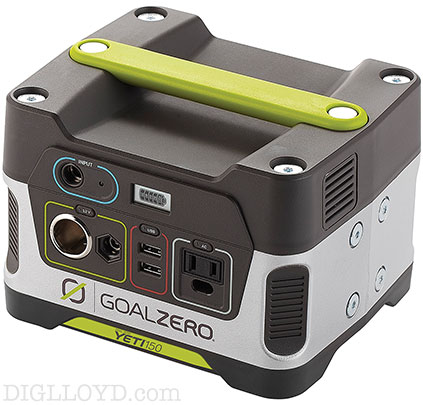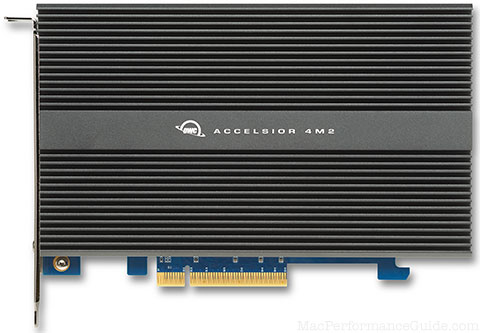

|


|

$200 Leica BP-SCL6 Lithium-Ion Battery (8.4V, 2200mAh) BACK IN STOCK in Accessories: Batteries and Power
|

|

|

|
GOAL ZERO Yeti 150 Solar Generator Power Pack

See my solar and battery power charging wish list at B&H Photo.
Back in 2015, Up in the Mountains in a Canyon, What to do for Power for a Laptop? collected various options for powering a laptop in the field. In 2016 I had a chance to test several Goal Zero Yeti solar power products first hand.
The Yeti 150 or Yeti 400 power packs are batteries that can be charged via AC power, car lighter socket or solar panels. Both offer both USB and AC power outlets for recharging cameras or laptops and so on.
GOAL ZERO Yeti offers large battery packs and large solar panels as well, but these are generally applicable for large vehicles and longer camping stays such as base camps in remote areas.
The GOAL ZERO Yeti 400 Solar Generator Power Pack has a 396 Wh battery (2.35X more power) but weighs 29 pounds / 13.21 kg and is larger at 10.25 x 8 x 8 in. For those traveling in a vehicle, the Yeti 400 makes a lot more sense, with its much higher capacity. It also charges to capacity just as fast as the Yeti 150, when using AC power.
The GOAL ZERO Yeti 150 Solar Generator Power Pack incorporates a 168 Wh AGM Lead Acid battery pack with a carry handle. Its size and weight fit easily into any car, back seat, or even a daypack.
- 7.75 x 5.75 x 6.75" / 19.7 x 14.6 x 17.2 cm, 12 pounds / 5.4 kg
- Operating Temperature Range 32-104° F (0 - 40° C)
- 1 x AC standard US outlets 110 VAC 60 Hz modified sine wave, 80 W max total continuous, 160 W max short-duration.
- 2 x USB 5V, 2.1 Amp max (10 W max), regulated
- 110 VAC Wall Charger: 6 hours
12 VDC Car Charger: 8 hours
Nomad 13 Solar Panel: 26-52 Hours
Nomad 20 Solar Panel: 17-34 Hours
Boulder 15 Solar Panel: 22-44 Hours - 1 x 6 mm, 12 V ports, 10 Amp max (120 W), regulated and Female 12 VDC port, 10 Amp max (120 W), unregulated
As with lead-acid jump starter style batteries, failure to keep the battery charged quickly degrades its service life. The battery should be kept topped off regularly, letting no more than 3 months elapse before recharging. The Goal Zero Yeti replacement batteries are about 25% of the cost of the original unit, plus about $10 more for shipping (for Yet 400 battery). Unlike APC, Yeti does not seem to offer a return program for old batteries, so apparently users are on their own for disposal of the old battery. This is a big NO NO for a “green” company that is inexplicable.
Charging devices
Charging USB devices is no problem, just plug and go: cameras, phones, tablet, etc.
AC power up to 80 watts continuous load is possible, including power hungry laptops.
Recharging a power hungry pro laptop
A big plus of the Yeti 150 is that it has a built-in power inverter for its AC outlet. That the Yeti 150 can operate as an inverter with its own battery supply is a big plus for travel, as it can even out the charge load. I typically carry a Wagan Tech 200W pure sine wave power inverter @AMAZON in an SUV, but when the engine is not running, the SUV cuts power to the outlet for excessive power draw for more than 5-10 minutes. For example, a mostly discharged MacBook Pro Retina draws ~90 watts during initial recharging (steady-state draw is lower). Thus the Yeti 150 offers a way to recharge a laptop when the vehicle balks.
The Yeti 150 was able to sustain an 88 watt load from the MacBook Pro Retina (starting with laptop battery at 22%), according to the Watts Up Pro power meter @AMAZON (the laptop power brick was plugged into the WattsUp, which was plugged into the Yeti). That exceeds the specified continuous power draw rating of 80 watts.
AC power quality appears to be not so good (square wave?): when I plugged in a fan drawing 44 watts, the fan made a very annoying sound that does not occur when plugged into a wall outlet; clearly the Yeti 150 is not supplying the same quality power as a household outlet. Thus the Yeti 150 does not appear to be a good choice for powering AC-power devices with motors.
Recharging the Yeti 150: AC, 12V car outlet, solar
The -supplied AC charger draws 45.5 watts while charging, as tested and according to the Watts Up Pro power meter @AMAZON. Plugging the same charger into a Wagan Tech pure sine wave power inverter @AMAZON in an SUV, the same 45.5 watt power draw was seen. Yeti states 6 hours for charging the Yeti 150 via AC power, same for Yeti 400. All other types of recharging take longer.
Charging Yeti 150 via 12V socket in car
Yeti’s car charging solution, the 8.0MM 12V CAR CHARGER is not supplied with the Yeti 150, yet that is the most useful accessory of all (for me) while traveling. Nor does the Yeti 400 include it. While inexpensive, the hassle and delay of obtaining the car charger make me question Yeti’s judgment. For starters, neither B&H nor Amazon carry the $5.99 Yeti Goal Zero 8.0MM 12V CAR CHARGER plus Yeti charges $8.99 for shipping—50% more than the cost of the adapter itself—$14 and a delay! It’s an asinine sales approach. As it is, I was unable to test charging the Yeti 150 using the car charger because of the omission.
The Yeti 8.0MM 12V CAR CHARGER is stated to draw 30 watts (vs 45 watts for AC), and to take 8 hours to fully charge the Yeti 150 (13 hours for Yeti 400). Ironically the best solution for rapid car charging is to use a high quality pure sine wave power power inverter @AMAZON, plugging the Yeti 150 AC power brick into it, thus reducing charge time to 6 hours instead of 8 hours (6 hours instead of 13 hours for Yeti 400, assuming the vehicle and power inverter can handle the ~90 watt load ).
Charging the GOAL ZERO Yeti 150 battery pack with solar panels
The GOAL ZERO Yeti 150 battery pack can be charged using the Nomad 20 solar panel.

(Yet 150 recharges with AC, car charger or solar panel)
Conclusions
See my solar and battery power charging wish list at B&H Photo.
The GOAL ZERO Yeti 150 Solar Generator Power Pack is a nice little unit.With ample power for small electronics it nonetheless may fall somewhat short for powering a high-power-draw pro laptop. Still, it should greatly extend the runtime of a MacBook Pro Retina.
If space and weight are not a concern, the GOAL ZERO Yeti 400 Solar Generator Power Pack is only moderately larger, and makes a lot of sense for 2.5X the capacity of the Yeti 150, as well as offering dual AC ports, which come in handy for scenarios like powering a laptop plus a camera battery charger.






















